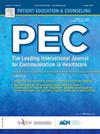探讨数字化跨学科会诊中患者参与及影响因素
IF 3.1
2区 医学
Q2 PUBLIC, ENVIRONMENTAL & OCCUPATIONAL HEALTH
引用次数: 0
摘要
目的探讨患者在数字化跨学科会诊(DICO)过程中的态度和体验,并确定其影响因素。DICO被定义为全科医生和医院专家之间通过安全的电子应用程序进行异步、有针对性的通信,在该应用程序中共享患者特定信息,并寻求有关临床问题的澄清或指导。方法在荷兰进行定性研究。根据文献研究和专家会议,反复开发了一个概念框架,以确定患者可能参与的DICO阶段。来自三个相关研究的数据进行了半结构化访谈,涉及不同类型的DICO患者的经历。根据患者访谈的结果,概念框架扩展了影响每个阶段患者参与程度的因素。结果对27例患者访谈进行分析。患者将DICO视为护理的第一步,需要的积极参与有限。从患者的角度来看,启动DICO的决定通常是由全科医生做出的,通常没有患者的意见。全科医生因各种原因启动DICO,患者参与程度因原因而异。患者认为影响参与的关键因素包括gp与患者的关系,特别是信任,医疗问题的性质(例如,紧迫性和严重性),以及患者的需求和偏好。患者赞赏DICO后的讨论,特别是在不确定的情况下,并认为在DICO导致健康决策时共同决策很重要。结论:该研究强调了患者参与DICO的程度是如何根据开始DICO的原因、医疗问题的性质、患者的需求和偏好以及gp -患者关系而变化的。实践意义:本研究的结果表明,患者参与DICO是依赖于环境的;全科医生应根据不同的DICO阶段量身定制参与,特别是在对DICO的结果提供反馈时。研究结果可以为未来有效的、以患者为中心的DICO实施提供指导。本文章由计算机程序翻译,如有差异,请以英文原文为准。
Exploring patient involvement and influencing factors in digital interdisciplinary consultation
Objectives
We explored patient attitudes and experiences around their involvement throughout the digital interdisciplinary consultation (DICO) process and identified its influencing factors. DICO is defined as asynchronous, targeted communication between GPs and hospital specialists via a secure electronic application where patient-specific information is shared, and clarification or guidance is sought concerning a clinical question.
Methods
We conducted a qualitative study in the Netherlands. A conceptual framework was iteratively developed to identify phases of DICO where patient involvement is possible, drawing on literature research and expert meetings. Data from three interrelated studies performing semi-structured interviews regarding patients' experiences with various types of DICO were triangulated. The conceptual framework was expanded with factors influencing the degree of patient involvement at each phase, based on the findings from the patient interviews.
Results
We analyzed 27 patient interviews. Patients viewed DICO as an initial step in care, with limited active involvement required. From the perspective of the patient, the decision to initiate DICO is typically made by the GP, often without patient input. GPs initiate DICO for various reasons and patient involvement varies depending on the reason. Key factors influencing involvement as perceived by patients include the GP-patient relationship, particularly trust, the nature of the medical problem (e.g., urgency and severity), and patients’ needs and preferences. Patients appreciated post-DICO discussions, particularly in cases of uncertainty, and considered shared decision making important when DICO leads to health decisions.
Conclusions
The study highlights how the level of patient involvement in DICO varies depending on the reason for initiating DICO, the nature of the medical problem, patients’ needs and preferences, and the GP-patient relationship.
Practice implications
Findings from this study show patient involvement in DICO is context-dependent; GPs should tailor involvement across multiple DICO phases, especially when providing feedback on the outcome of DICO. Findings can contribute to future guidelines for effective, patient-centered DICO implementation.
求助全文
通过发布文献求助,成功后即可免费获取论文全文。
去求助
来源期刊

Patient Education and Counseling
医学-公共卫生、环境卫生与职业卫生
CiteScore
5.60
自引率
11.40%
发文量
384
审稿时长
46 days
期刊介绍:
Patient Education and Counseling is an interdisciplinary, international journal for patient education and health promotion researchers, managers and clinicians. The journal seeks to explore and elucidate the educational, counseling and communication models in health care. Its aim is to provide a forum for fundamental as well as applied research, and to promote the study of organizational issues involved with the delivery of patient education, counseling, health promotion services and training models in improving communication between providers and patients.
 求助内容:
求助内容: 应助结果提醒方式:
应助结果提醒方式:


